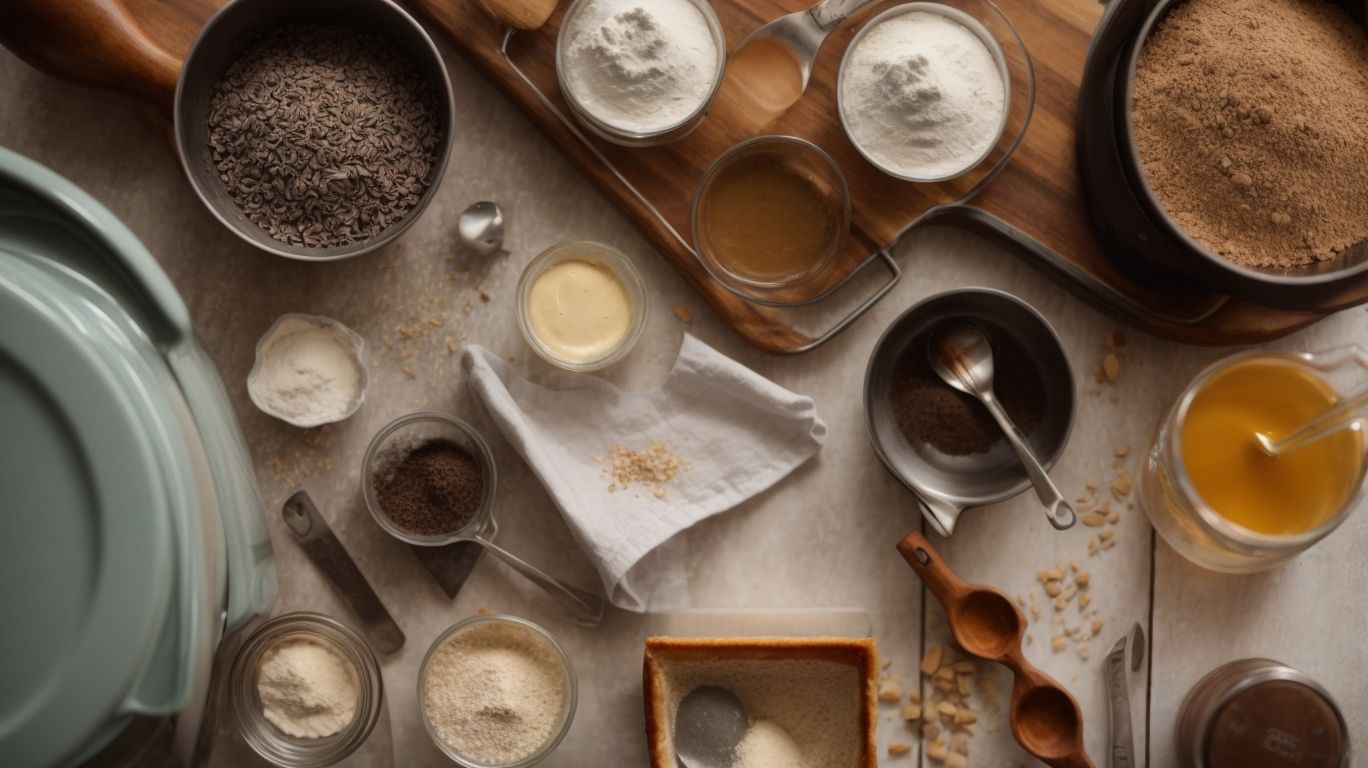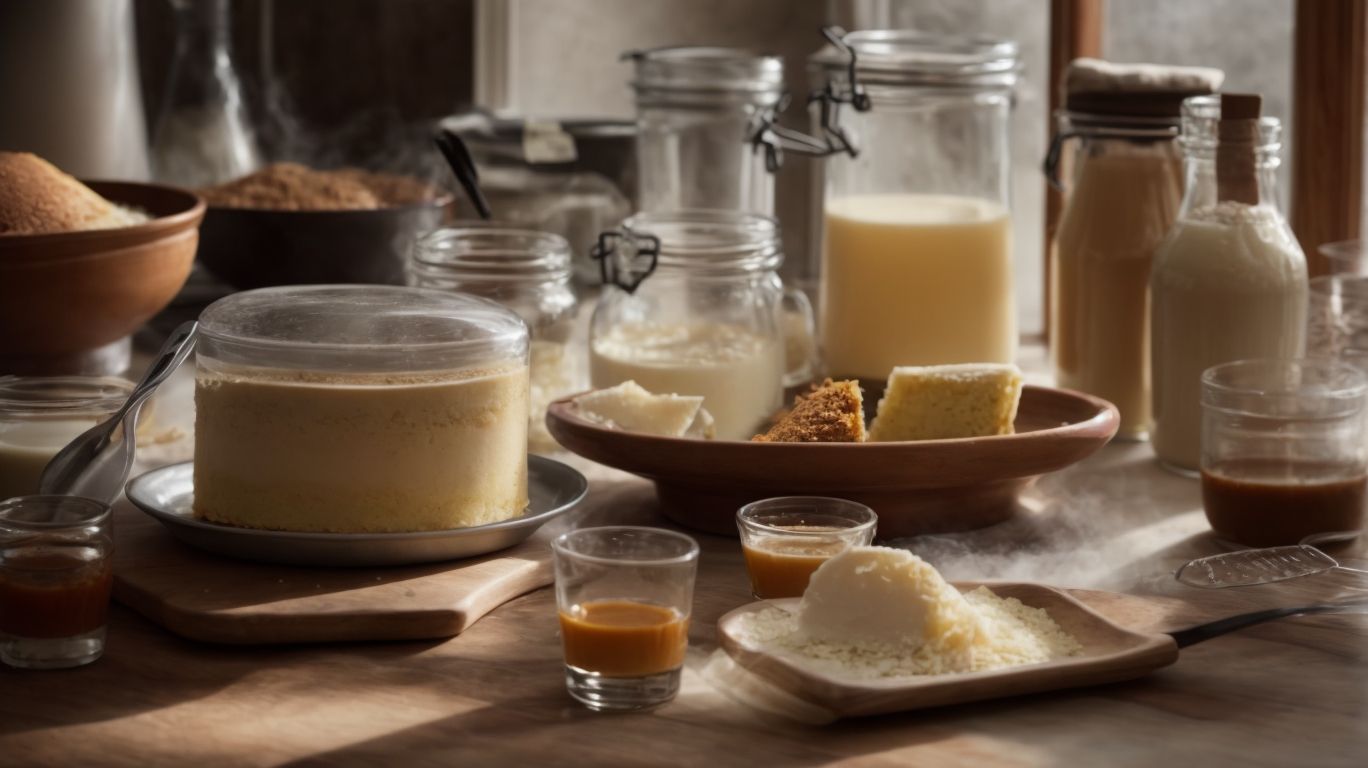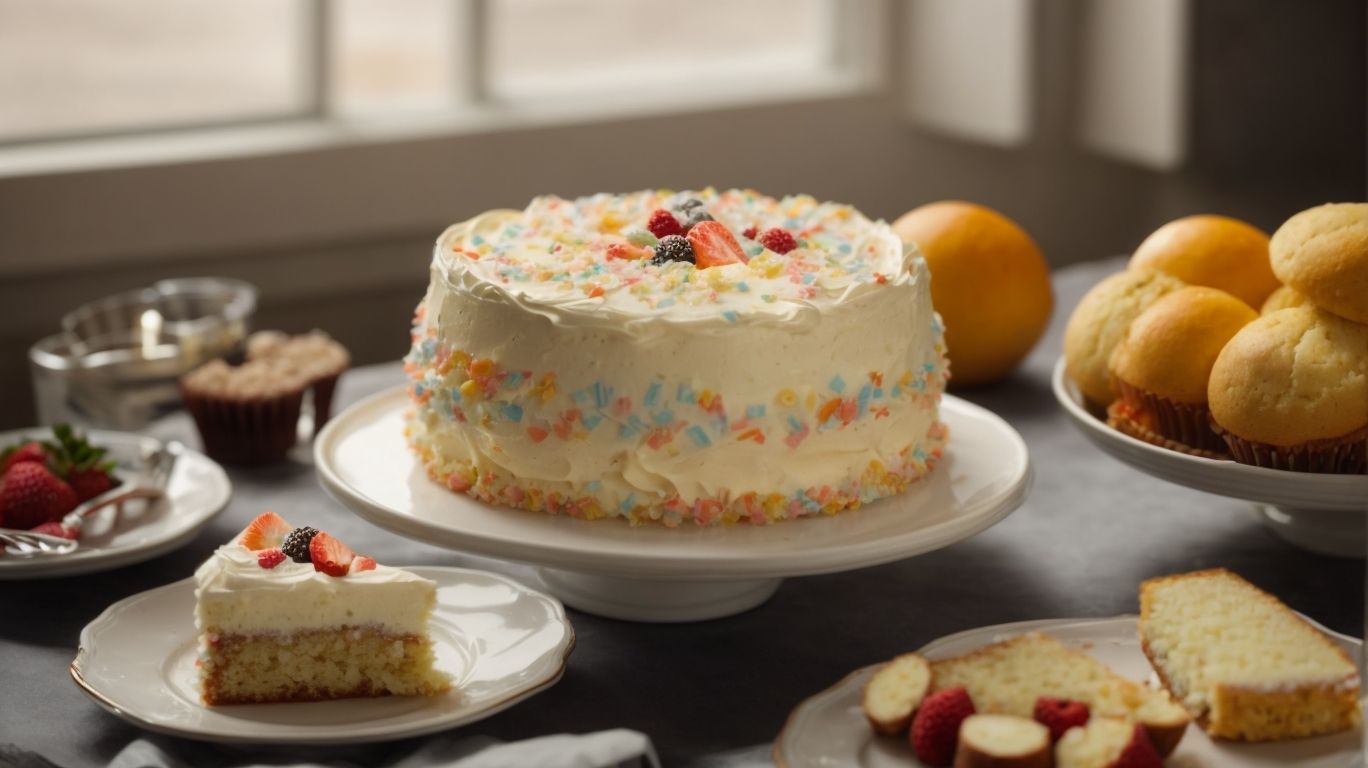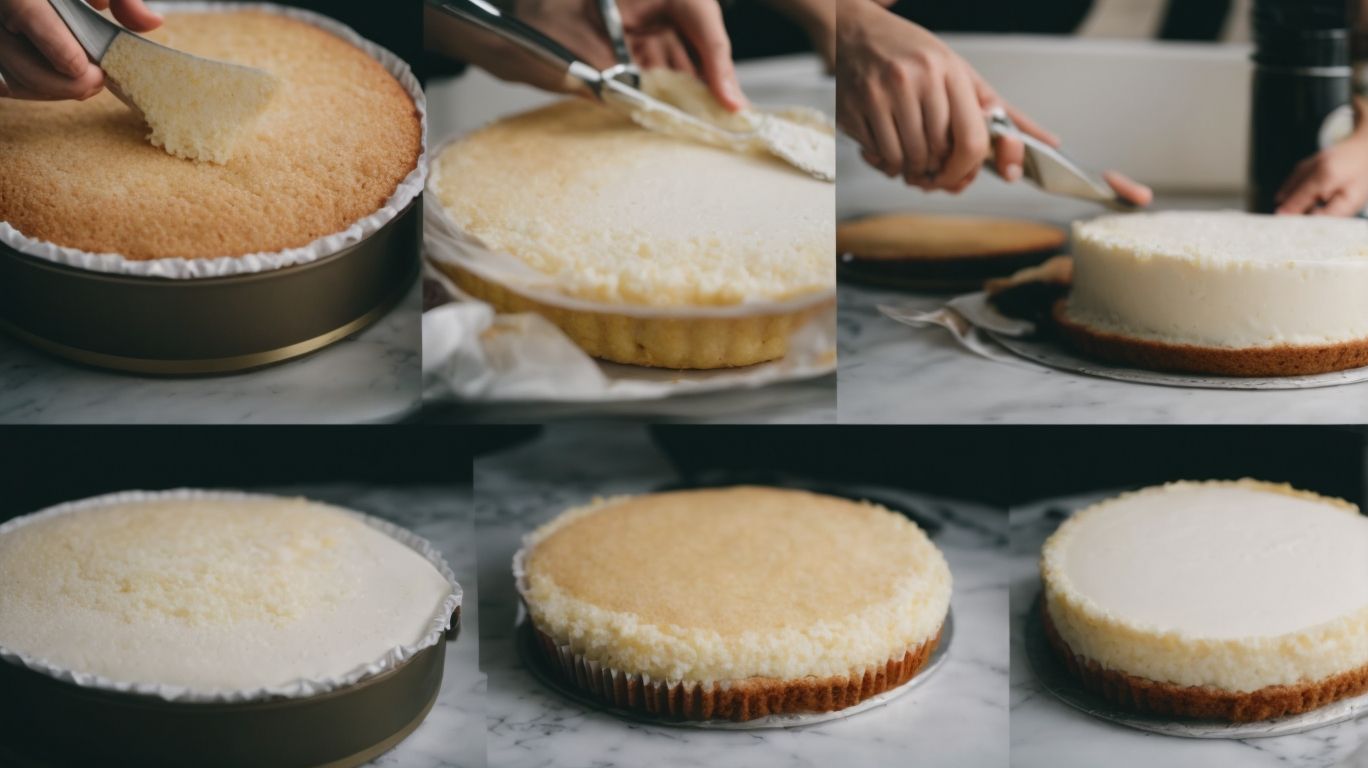How to Bake a Simple Cake for Beginners Without Oven?
Are you a beginner baker looking to make a delicious cake without an oven? Look no further!
In this article, we will walk you through the necessary ingredients and tools needed to bake a cake, as well as provide you with step-by-step instructions on how to bake a simple cake on the stovetop.
We will share some tips and tricks to ensure your cake comes out perfectly every time. Keep reading to become a pro in no time!
Key Takeaways:
What are the Necessary Ingredients for Baking a Cake?
When baking a delicious cake, you need essential ingredients like cocoa powder, vanilla extract, eggs, milk, sugar, butter, flour, baking powder, salt, and vegetable oil.
Cocoa powder adds a rich chocolate flavor to the cake, while vanilla extract enhances overall taste and aroma. Eggs provide structure and stability, and milk adds moisture for a tender crumb.
Sugar sweetens the cake and contributes to texture, while butter lends richness and moisture. Flour serves as the base, giving structure, and baking powder helps with leavening for a light, fluffy texture.
Salt enhances flavors and balances sweetness, and vegetable oil can be a suitable substitute for butter in some recipes for a different texture.
Flour
Flour is a crucial component in cake baking, providing the structure and texture to the final product. There are different types of flour used in baking, such as self-rising flour and all-purpose flour.
Self-rising flour is a type of flour that already contains leavening agents like baking powder and salt, making it convenient for recipes that require a rise. On the other hand, all-purpose flour is versatile and can be used in a variety of baked goods, offering a balance between protein content and gluten development.
When choosing the right flour for cakes, consider the type of cake you are making. For delicate cakes like sponge or chiffon cakes, cake flour with a lower protein content is recommended for a tender crumb.
Sugar
Sugar plays a dual role in cake baking, providing sweetness and contributing to the texture and tenderness of the cake.
Common types of sugar used include granulated sugar and brown sugar.
Granulated sugar is the most commonly used type of sugar in baking due to its fine texture and ability to dissolve easily in batter.
On the other hand, brown sugar contains molasses, which gives it a richer flavor and moistness.
Adjusting sugar levels in a cake recipe can be done based on personal preference; reducing sugar may result in a less sweet but denser cake, while increasing sugar can lead to a sweeter and moister outcome. Experimenting with different sugar quantities can help tailor the cake to suit individual taste preferences.
Eggs
Eggs are a binding agent in cake recipes, contributing to the structure, moisture, and richness of the final product. Large eggs are commonly used in baking for consistent results.
Regarding handling eggs for cakes, it is crucial to ensure they are at room temperature before incorporating them into the batter. This helps the eggs blend more easily, giving the cake a smoother texture. Using the precise number of eggs as stated in the recipe is vital to maintain the intended balance of moisture and structure in the cake.
For lighter cakes, such as sponge cakes, gently folding beaten egg whites into the batter helps to create a fluffy, airy texture. Conversely, for denser cakes like pound cakes, beating whole eggs thoroughly with the sugar adds richness and density.
Butter
Butter adds flavor, moisture, and richness to cakes, enhancing their overall taste and texture. While butter is a popular choice, some recipes may use margarine as a substitute.
Regarding baking, butter is a key ingredient that influences the final outcome of your cake. Butter not only provides a rich and indulgent flavor but also contributes to the moistness and tenderness of the crumb. In contrast, margarine, a common butter substitute, contains more water and vegetable oils, which can impact the texture and taste of the cake.
Choosing the right butter for your cake is crucial. Unsalted butter is preferred in baking to control the salt content in the recipe. Opt for high-quality butter with a higher fat content for a richer flavor and better texture.
For different types of cakes, such as pound cakes or butter cakes, European-style butter with higher butterfat content can elevate the flavor and texture of your baked goods. When making delicate cakes like genoise or sponge cake, consider using clarified butter for a smoother texture.
Baking Powder
Baking powder is a leavening agent that helps cakes rise and achieve a light, airy texture. It is a key ingredient in many cake recipes, ensuring proper leavening.
When mixed in the batter, baking powder releases carbon dioxide gas bubbles upon contact with liquids and heat during baking, causing the cake to expand and rise. This reaction creates air pockets that give the cake a soft and spongy consistency, making it desirable and palatable. It’s crucial to measure the right amount of baking powder to avoid an overly puffy or dense cake, as excess can leave a bitter aftertaste.
For lighter cakes like sponge cakes, a gentle hand while folding in the batter is recommended to preserve the gas released by the baking powder. On the other hand, for denser cakes such as pound cakes, a bit more baking powder may be required to create a slightly more open crumb structure.
Store baking powder in a cool, dry place to maintain its effectiveness, as expired or improperly stored baking powder may result in flat and dense cakes, failing to achieve the desired rise and texture.
What are the Required Baking Tools?

Credits: Poormet.Com – Jerry Smith
Plus ingredients, essential baking tools are required for cake preparation. These tools include a mixing bowl, measuring cups and spoons, whisk or electric mixer, baking pan, and parchment paper.
Each of these tools plays a crucial role in achieving the perfect texture, consistency, and appearance of your cakes. The mixing bowl is where all the ingredients come together harmoniously, while the measuring cups and spoons ensure precise amounts for the recipe. A whisk or electric mixer is essential for blending ingredients smoothly, ensuring a uniform batter.
Choosing the right tools for different cake recipes is key to success. For instance, a springform pan is ideal for delicate cakes like cheesecakes, ensuring easy removal without damaging the edges. Parchment paper also prevents sticking and helps with even baking.
Mixing Bowl
A mixing bowl is a fundamental tool for combining cake ingredients thoroughly. Choosing the right size and material of the mixing bowl is essential for successful cake preparation.
Regarding selecting the appropriate mixing bowl, it’s crucial to consider the volume of ingredients to be mixed. For larger batches, opt for a spacious bowl that provides ample room for thorough mixing without spillage. Stainless steel mixing bowls are durable and versatile, suitable for various recipes. Glass bowls, on the other hand, allow for easy monitoring of the mixing process and can be used for both mixing and serving.
Measuring Cups and Spoons
Accurate measurement of ingredients is crucial in baking, making measuring cups and spoons essential tools for precise ingredient quantities. Using the right measuring tools ensures consistency in baking results.
When measuring ingredients, it’s essential to use the correct method to avoid discrepancies in your recipes. For solid ingredients like flour and sugar, spooning them into the measuring cup and leveling off the excess with a straight edge is the most accurate technique. With liquids, place the measuring cup on a leveled surface and read the measurement at eye level for precision. When you need to convert measurements, remember that 1 cup equals 16 tablespoons or 48 teaspoons, aiding you in adjusting your recipe quantities accordingly.
If you ever find yourself needing to convert between different measurement systems, such as ounces to grams or cups to milliliters, refer to a reliable conversion chart for baking to avoid errors and maintain the quality of your baked goods.
Whisk or Electric Mixer
Whisks and electric mixers are essential for achieving uniform and smooth cake batter.
Selecting the appropriate tool based on the recipe and desired texture is key to successful cake preparation.
Whisks
- Whisks are ideal for light and airy cakes, requiring a gentle hand to blend ingredients without overmixing.
On the other hand,
Electric mixers
- Electric mixers are fantastic for heavier batters, such as those with thick consistencies or incorporating air into dense mixtures.
When opting for a manual whisk, the technique of gently folding ingredients together in a circular motion is essential to maintain the airiness of the batter.
Conversely, using an electric mixer, start at a low speed to prevent splattering and gradually increase to achieve the desired consistency.
Baking Pan
Baking pans are necessary for shaping and baking cakes to perfection. Choosing the right type and size of the baking pan ensures even baking and desired cake dimensions.
When selecting a baking pan, consider the material it’s made of; for example, non-stick pans are excellent for delicate cakes. Size matters as well; a deep pan is ideal for dense cakes, while a shallow pan is suitable for lighter sponges. Greasing the pan properly with butter or oil prevents sticking, ensuring the cake maintains its shape when removed. Silicon pans are great for easy release, while metal pans conduct heat efficiently for a golden crust. A well-prepared pan sets the stage for a successful, delicious cake creation.
Parchment Paper
Parchment paper is a versatile tool that aids in easy cake release and prevents sticking. Lining the baking pan with parchment paper ensures smooth cake removal and minimal cleanup.
Parchment paper is heat-resistant and non-stick, making it ideal for various baking purposes. It helps to regulate the temperature of baked goods evenly, resulting in perfectly cooked treats every time.
When using parchment paper, there is no need for additional greasing, reducing the fat content in your baked goods. Another benefit is that parchment paper can be reused multiple times, saving both money and the environment. Simply wipe it down and let it dry before using it again for your next baking project.
This eco-friendly and convenient kitchen essential is a must-have for any avid baker.
Step-by-Step Instructions for Baking a Simple Cake without an Oven

Credits: Poormet.Com – Henry Mitchell
If you want to bake a delicious cake without an oven, alternative cooking methods like a microwave, slow cooker, or stovetop can be used. Each method offers unique challenges and requires specific adjustments.
-
When using a microwave to bake a cake, make sure to use a microwave-safe container and adjust the cooking time accordingly to prevent overcooking or undercooking.
-
For slow cooker baking, line the cooker with parchment paper to avoid sticking, and monitor the cake’s progress as it may take longer than traditional methods.
-
When using a stovetop, opt for a heavy-bottomed pan to ensure even heat distribution, and cover the pan to trap steam, aiding in the cake’s rising process.
Preparing the Batter
Before baking, preparing the cake batter is a crucial step. Ensure all ingredients are properly measured and mixed to achieve a smooth and consistent batter for a successful cake.
Start by gathering all the necessary ingredients laid out neatly on your workstation. Measuring cups and spoons are your allies in ensuring precision in each component.
Properly creaming together the butter and sugar is key as it incorporates air into the mixture, resulting in a light and fluffy texture.
Add eggs one at a time, ensuring each is fully incorporated before adding the next, to maintain the emulsion and prevent curdling.
Gradually sift in the dry ingredients in batches, gently folding to prevent overmixing, which can lead to a dense cake.
Preparing the Baking Pan
Properly preparing the baking pan is essential to prevent cake sticking and ensure easy removal. Greasing and flouring the pan or using parchment paper are common methods to prepare the baking surface.
Selecting the right method depends on the type of cake you’re making. For delicate cakes like angel food or chiffon, opt for parchment paper for a smooth release. Dense cakes benefit from greasing and dusting with flour for added texture. Remember to grease the sides of the pan as well, not just the bottom, to prevent any potential sticking. Another handy tip is to sift flour evenly onto the greased pan and tap out excess to cover all surfaces uniformly. Taking care in this step will result in perfectly baked cakes with flawless edges that are ready for easy plating and decorating.
Baking the Cake on Stovetop
Baking a cake on the stovetop can be a convenient alternative when an oven is not available. Managing heat distribution and using hot water baths are vital techniques for successful stovetop baking.
When baking on a stovetop, it’s crucial to choose the right pan – a heavy-bottomed, deep pan with a tight-fitting lid works best to ensure even heat distribution. Adjusting the temperature throughout the process is key. Use a low flame to preheat the pan gradually, then maintain a consistent low to medium heat during baking. Incorporate a water bath by placing your cake pan in a larger pan of simmering water to add moisture and control the baking temperature.
Tips and Tricks for Perfectly Baked Cake

Credits: Poormet.Com – Bruce Davis
Achieving a perfectly baked cake requires attention to detail and following certain tips and tricks. Factors like using room temperature ingredients, avoiding overmixing, choosing the right baking pan, and checking doneness with a toothpick are crucial for success.
Another essential tip for baking a flawless cake is to measure ingredients accurately. Consistency in measuring flour, sugar, and leavening agents ensures the proper balance of ingredients, leading to a well-textured cake.
Preheating the oven adequately before placing the cake batter inside helps in achieving even baking and proper rise.
Ensuring that the cake cools completely in the pan before removing it is vital to prevent it from breaking apart. This process allows the cake to set properly and prevents any crumbling as it’s being transferred onto a cooling rack for further cooling.
Use Room Temperature Ingredients
Using room temperature ingredients like eggs and butter ensures proper incorporation and uniform texture in the cake batter. Allow these ingredients to come to room temperature before baking for optimal results.
Room temperature ingredients not only mix more easily, but they also create a smoother batter, resulting in a fluffier and more consistent cake texture. When cold ingredients are added to the mix, they can harden the fats in the batter, leading to an uneven distribution and a heavier end product.
To quickly bring eggs to room temperature, place them in a bowl of warm water for 5-10 minutes. For butter, try cutting it into smaller pieces and leaving it out on the counter for 30-60 minutes before starting your recipe.
Do Not Overmix the Batter
Overmixing the cake batter can lead to a tough or dense texture in the final product. Mix the batter until just combined to avoid overworking the ingredients.
When batter is mixed excessively, the gluten in the flour gets overdeveloped, resulting in a dense and chewy texture rather than a light and airy crumb. It can also lead to the formation of air pockets, causing uneven baking and an uneven rise. For achieving the ideal consistency, follow specific guidelines for each type of cake batter – gently fold in dry ingredients for sponge cakes to maintain a fluffy texture, while for pound cakes, a more thorough mixing may be required for a denser crumb.
Use the Right Baking Pan
Selecting the appropriate baking pan size and type is crucial for achieving the desired cake texture and dimensions. Matching the pan to the recipe specifications ensures even baking and proper rise.
When selecting a baking pan, consider the recipe’s instructions on pan size and type, as different shapes and materials can impact the baking process. For cakes that need to rise, opt for deep pans to prevent spillage and facilitate a good rise. Non-stick pans are ideal for delicate cakes to ensure easy removal without damaging the texture. Understanding how pan size affects baking times is essential; a smaller pan may result in a denser cake requiring longer baking, while a larger pan can lead to quicker baking with potential texture changes.
Check for Doneness with a Toothpick
Testing the cake for doneness with a toothpick is a reliable method to ensure it is fully baked.
This quick and simple technique involves inserting a toothpick into the center of the cake and pulling it out to check for any batter residue. If the toothpick comes out clean, it indicates that the cake is perfectly baked, moist, and ready to be removed from the oven. If crumbs or wet batter stick to the toothpick, the cake needs more time to bake. Be cautious not to overbake the cake by mistaking melted chocolate chips or other fillings for uncooked batter clinging to the toothpick.
Conclusion
Mastering the art of cake baking requires attention to detail, quality ingredients, and proper techniques. By following the tips and guidelines provided, you can create delectable cakes that delight your taste buds.
Remember, the foundation of any great cake lies in the ingredients you choose. Quality ingredients like fresh eggs, real butter, and pure vanilla extract will elevate your cake to new heights. Equally important is the need to follow precise measurements and baking times to ensure a perfect outcome. Whether you’re a beginner or a seasoned baker, keep practicing and experimenting with different flavors and decorations to unleash your creativity in the kitchen. So, don’t be afraid to dive into the wonderful world of cake baking and let your passion for baking shine through!
Frequently Asked Questions
What is the best recipe for baking a simple cake for beginners without an oven?
There are many recipes available for baking a simple cake without an oven, but one of the most popular is the no-bake chocolate cake. It only requires a few ingredients and can be made in a pressure cooker or on the stovetop.
Can I substitute any ingredients in the no-bake chocolate cake recipe?
Yes, you can substitute ingredients based on your preferences or dietary restrictions. For example, you can use gluten-free flour or dairy-free milk in place of regular flour and milk.
How do I know when the cake is ready to be taken out of the pressure cooker or stovetop?
The best way to check if the cake is ready is by inserting a toothpick in the center. If it comes out clean, the cake is done. If there is batter on the toothpick, it needs more time to bake.
What type of pan should I use to make a no-bake chocolate cake on the stovetop?
You can use a regular cake pan or a deep pan with a lid on the stovetop. The important thing is to make sure it has a flat bottom and fits comfortably on your stovetop.
Can I decorate the no-bake chocolate cake with frosting?
Absolutely! You can use any type of frosting or icing to decorate your cake. You can also add toppings like fresh fruits, nuts, or chocolate shavings for extra flavor and texture.
Is it possible to make a no-bake chocolate cake without using any heat at all?
Yes, you can make a no-bake chocolate cake using only chilled or room temperature ingredients. This method requires no cooking or heating, making it a great option for hot summer days or when you don’t have access to a stove or pressure cooker.

